Getting Around, Mexico City Travel, Transport and Car Rental
(Mexico City, Federal District, Mexico)
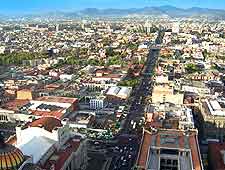
Mexico City is a vast city and visitors will likely be overwhelmed by its size. However, getting around much of Mexico City need not be difficult and the city boasts a fairly comprehensive transport network, with various convenient and inexpensive ways to travel around.
The metro train system in Mexico City is known as the 'Sistema de Transporte Colectivo' and these trains provide the fastest way to travel around the city, with an average of almost five million passengers using metro transport each day of the week. Bus transport, electric trolleys, taxis and car rental are all further ways to travel throughout Mexico City, although driving around the city centre can be a challenge to say the least.
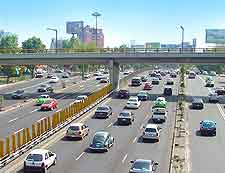
Benito Juarez International Airport (MEX) / Arriving by Air
Known locally in Mexico City as the Aeropuerto Internacional de la Ciudad de México or the
Benito Juarez International Airport, this airport is one of Mexico's premier transport hubs. An enormous selection of airlines provide travel to over 100 different destinations around the world, with its single terminal divided into six separate hall areas (salas). Mexico City Airport is around 13 km / 8 miles east of the Zócalo and serves both international and domestic airlines, with travel options including its very own Metro station, bus and shuttle transport, and both taxis and limos.
Mexico City International Airport (MEX) Guide
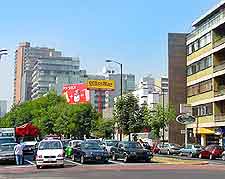
Car Rental
Travelling around Mexico City by rental car is not advisable, unless you are a confident driver, prepared for constant traffic jams and ready for a challenge, or intending to travel outside of the city environs. Locals in Mexico City are known for their reckless driving, ignoring many basic rules of the road, driving through red traffic lights and not always sticking to speed limits. However, you are able to turn right, even when the traffic light is red.
Whilst the main roads in downtown Mexico City are generally in good condition, many side streets and avenues feature potholes and also rather high speed bumps. Parking can be a real problem, so when planning to use rental cars for transport in Mexico City, check that your hotel contains a garage area or similar arrangement.
Mexico City also features a 'Don't Drive Today' (Hoy No Circula), where many vehicles are banned from travelling within the city centre on specified days - determined by their registration number, in an attempt to combat transport related pollution problems. Most hotels within the city feature their own guest garages, and so parking is rarely a problem for tourists staying in Mexico City who choose to hire a car. Rental travel agencies are found at the airport and around the Zona Rosa.
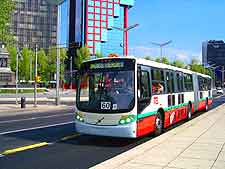
Buses and Coaches
Mexico City is home to four individual long-distance bus stations as follows:
- Mexico City Bus Transport: Terminal Norte / North (Terminal de Autobuses del Norte) - buses travel north to cities bordering the USA, west to Mexican locations such as Guadalajara and Puerto Vallarta, and south to Acapulco
- Mexico City Bus Transport: Terminal Oriente / East (Terminal de Autobuses de Pasajeros de Oriente) - buses travel both east and south-east, to Puebla, Veracruz and the Yacatan region
- Mexico City Bus Transport: Terminal Sur / South (Terminal Central de Autobuses del Sur) - buses travel south to Acapulco, Cuernavaca, Taxco and Tepoztlán
- Mexico City Bus Transport: Terminal Poniente / West (Terminal Poniente de Autobuses) - buses travel west to the state of Michoacán and nearby Toluca
Bus transport is also available at Mexico City Airport, travelling to a number of destinations, including nearby cities. For journeys of longer than four or five hours, bus tickets can be purchased at the relevant bus station upon arrival. However, if you are planning to travel on long-distance bus transport from one of Mexico City's bus stations, do purchase your ticket in advance, since many of these buses completely sell out. Tickets can also be purchased at various 'Ticketbus' outlets dotted around central Mexico City.
Within Mexico City itself are literally thousands of RTP buses (government run), mini-buses (privately run micros or peseros), and electric trolley buses, which travel between the hours of 05:00 and 20:00. Exact change is always required when travelling on the City Government RTP buses in Mexico City and in general, these buses tend to be more comfortable than the microbuses. Limited bus transport is also available at night, particularly around the Paseo de la Reforma and the Avenida Insurgentes. In total, Mexico City is home to 15 separate trolley bus lines and this transport tends to be less crowded and slightly slower than RTP buses.
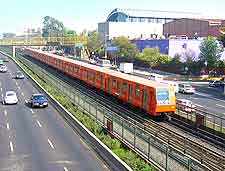
Metro
In total their are just less than 200 metro stations in Mexico City, with 11 lines stretching for more than 200 km / 124 miles. During peak hours, metro trains travel every two or three minutes, between 05:00 to 00:30 Monday to Friday, 06:00 to 00:30 on Saturdays, and between 07:00 and 00:30 on Sundays. Metro transport in Mexico City is famous for being the cheapest of its kind in the whole world, although it does lack adequate English signage.
Taxis
The are a number of different classes of taxi transport available in Mexico City, with the cheapest taxi cabs simply found cruising around the streets, usually being a mixture of Nissan cars and green VW Beetles. However, for safety reasons, these should always be avoided. Only use taxis with official licence plates and visible ID cards (carta de identificación / tarjetón). In general, taxi travel is reasonably priced in Mexico City and always use meters (taximetro), rising between the hours of 23:00 and 06:00. Drivers do not usually expect a tip and radio taxi travel firms are available 24 hours a day.
 Mexico City is a vast city and visitors will likely be overwhelmed by its size. However, getting around much of Mexico City need not be difficult and the city boasts a fairly comprehensive transport network, with various convenient and inexpensive ways to travel around.
Mexico City is a vast city and visitors will likely be overwhelmed by its size. However, getting around much of Mexico City need not be difficult and the city boasts a fairly comprehensive transport network, with various convenient and inexpensive ways to travel around.



